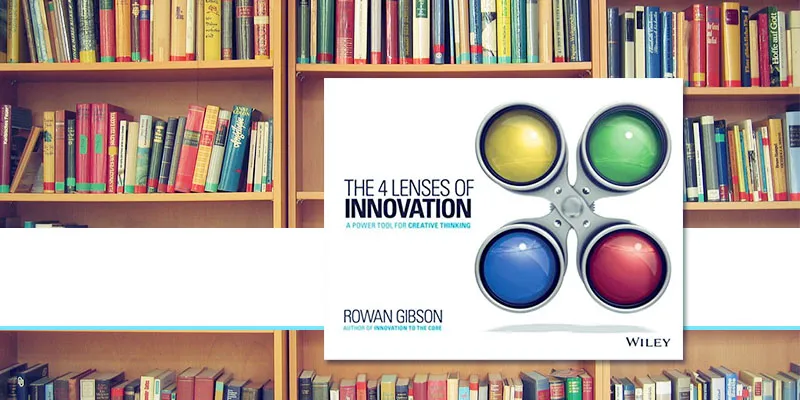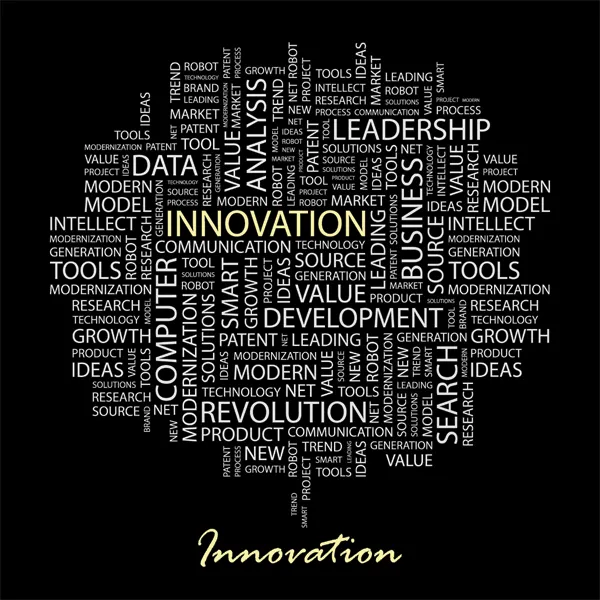Four lenses of innovation: how entrepreneurs can get creative insights for business success
"Creativity is like a muscle. If you don’t use it, you lose it,” says innovation guru Rowan Gibson in his new book, ‘The four lenses of innovation: a power tool for creative thinking.’
Gibson identifies four key business perspectives that will enable organisations to discover opportunities for innovation and growth, and offers eight steps for innovators to put these lenses into action for creative insights.

His earlier books are ‘Innovation to the Core’ and ‘Rethinking the Future.’ Gibson has also co-founded the site InnovationExcellence.com, and has addressed a range of companies including Accenture, Apple, Bayer, Credit Suisse, Dow Chemicals, Haier, Heineken, IBM, Microsoft, Philips, P&G, Siemens, Telefonica and Volkswagen.
His 294-page book is vividly illustrated (almost too many colours!) and the material is sometimes repetitive, but it does a great job of unearthing patterns in innovation right from the Renaissance giants to today’s corporate leaders.
Here are my key takeaways from the perspectives and recommendations in the book; there is an online companion with additional material. See also my reviews of the related books ‘The Innovator’s DNA,’ ‘The Creator’s Code’ and ‘Zero to One.’
Lens 1: Challenging orthodoxies
What if the dominant conventions in your field, market, or industry are outdated, unnecessary, or just plain wrong? In early times, creativity was seen as a divine gift; the Renaissance challenged the dominant paradigm and ‘blind faith’ of established organisations, best exemplified by thinkers like Galileo (astronomy), Martin Luther (religion), Andreas Vesalius (anatomy), Paracelsus (medicine), Descartes (philosophy), Newton (physics), Brunelleschi (painting), Columbus and Vespucci (cartography).
Modern day challengers include Elon Musk (electric cars and space rockets), and companies like NetFlix (disrupting physical store-based video rentals), Apple (direct retail stores), Swatch (repositioning watches as trendy), Lush (soaps by the slice), Nintendo (Wii gaming), Ikea (assembled furniture), Southwest Airlines (uniform aircraft but multi-skilled staff), Rolls Royce (engine maintenance contracts), Dell (direct to order computers), GE (portable ultrasound scanners), and Chipotle (healthy Mexican fast food).
Challenging orthodoxies includes becoming “cradles of creativity” to propose antithetical alternatives, as changing contexts require companies to revisit standard operating procedures, propose new ideas, shake up the bureaucracy, and enrich the ecosystem of connections. Innovators are sometimes seen as troublemakers, contrarians, heretics, misfits and rebels; they may even change a business model which already seems successful and doesn’t need to be modified.
Lens 2: Harnessing trends
Where are the shifts and discontinuities that will, now and in the future, provide the energy you need for a major leap forward? “Revolutionary breakthroughs are often built on some deep discontinuity,” observes Gibson; this cluster or convergence of trends leads to a disruption.
Innovators are not necessarily futurists, but they are imaginative and have an ability to use the power of change. “Innovators tend to have a wider field of view and an amazing sharp-sightedness,” says Gibson; they have more acute interest in the environment and are better at interpreting signals. This is all the more important in today’s era of exponential change.
Companies need to change at a rate and scale proportionate to their environment; those unable to see or act on change end up like Kodak or Nokia. Innovation is a race to the future, in the words of business guru C.K. Prahalad (see my quotes compilation and book review). Innovators need to be wave riders especially since some waves these days are like tsunamis.
Examples include AirBnB and Uber in the sharing economy; GE’s Industrial Internet initiatives; Amazon launching its own e-reader Kindle; Nike’s digital initiatives; Safaricom’s m-Pesa payment service in Kenya; Starbucks’ mobile payments app; Twitter’s acquisition of Vine; Google’s Android Wear OS for wearables; Virgin’s use of Google Glass for airport concierges; and the crowdsourced maps of Waze.

Image Credit "ShutterStock"
Lens 3: Leveraging resources
How can you arrange existing skills and assets into new combinations that add up to more than the sum of their parts? The awareness of “limitless capacity for developing, stretching and synthesizing resources” is the hallmark of an innovator. Innovators are focused not just on business performance but organisational creativity. They have an “elastic view” of their company and re-purpose, re-deploy and re-combine assets and competencies in innovative ways.
Examples include Disney, Corning, Google and Amazon stretching their skills and knowledge across a wide range of properties. Spain’s Grupo Matarromera also shows how companies can tap under-utilised assets; it makes cosmetics from grape skins discarded during wine-making. Imperial Billiards makes wooden pellets from unused sawdust; Raytheon converted a heating phenomenon from its radar experiments into the microwave oven.
Lens 4: Understanding needs
What are the unmet needs and frustrations that everyone else is simply ignoring? Being observant, empathetic and engaged helps identify and conceptualise new products and services. Innovators are “noticers” and have an unquenchable curiosity to unearth insights for customer solutions. They keep pushing the boundaries of current offerings by asking, ‘What’s wrong with it?’
Business leaders should be addressing not just their brands but their customer needs, segment by segment. At the same time, innovators should try to be a step ahead of customers, and balance technical R&D with customer research.
For example, P&G has a ‘Living It’ practice where researchers literally live with their customers for several days to get a deeper understanding of their lives and build stronger connects. Pulte Homes, the largest home-builder in the US, constantly taps home buyers to get consumer-inspired designs. Audi’s new cars have solar panels to run a car’s AC while parking, so that the car remains cool but doesn’t drain the battery.
Paint brand Dutch Boy designed ‘twist and pour’ containers for paint as an improvement on the messy tin cans. Summer Infant has designed a baby thermometer in the form of a pacifier instead of the traditional design. Nest has given a new creative twist to thermostats and heaters by app-enabling them and making them easier to use.
Cutting across the above four perspectives is the power to see existing patterns and break free from constraints. These include James Dyson (challenging the view that vacuum cleaners need bags), Jeff Besos (harnessing the Internet boom), ESPN (leveraging multiple channels for sports news) and Diane Hevin (seeing the need for women-only gyms). While patterns help deal with complexity and eventually become embedded in our behaviour, they also induce herd mentality and an inability to see differences even when they may be better. Innovation is about seeing beyond existing patterns to new emerging patterns.
8 steps to innovation
Building on the four lenses of innovation, Gibson offers an eight-step innovation process for organisations: (1) frame a challenge and focus on it (2) research the subject (3) immerse yourself in the problem (4) feel the creative frustration of the roadblock (5) detach and let the problem incubate in your unconscious mind (6) arrive at an illuminating insight (7) build the insight into a big idea (8) validate and execute on the idea. (Other variations of this are: preparation, incubation, intimation, illumination, verification. Also see my framework of ‘The 8 Is of Design Thinking for Startups.’)
Archimedes, Einstein and Edison are classic exemplars of this method. Not all innovators have followed this sequence; some steps can be skipped, and others have begun the innovation process via serendipitous or accidental insights, eg. an IKEA worker dismantling a table so it could be packed into his van; Diane Heavin noticing the discomfort of women in male-dominated gyms and starting the fitness chain, Curves.
Insights are sudden flashes of understanding which are accompanied by the ‘aha’ emotion of enlightenment, and trigger a leap of association or connection. They lead to better ideas which then converge on to the solution, eg. Kono’s cone-shaped pizza, Beats By Dre’s designer headphones.

Image Credit "ShutterStock"
It is therefore not enough for companies to just have fast idea flows, but to focus on those kinds of insights that yield the correct strategic solutions and then execute on them. Good insights are powerful, fresh, different from competitor offerings, and capable of galvanising excitement and action.
While there is certainly a role for innate talent and serendipity in innovation, it is possible to systematically combine creative thinking methods with the execution power of the modern business organisation. This also extends to the “recombinant creativity” in fertile environments like Silicon Valley.
The book is packed with useful quotes, and it would be appropriate to end this review with a sampling.
“Break is the important part of breakthrough.” – Matthew May
“Companies fall apart when their model is so successful that it stifles thinking that challenges it.” – Mark Parker
‘We always overestimate the change that will occur in the next two years and underestimate the change that will occur in the next ten.” – Bill Gates
“Entrepreneurs are the true heroes. They solve problems by creatively envisioning different ways the world could and should be.” – John Mackey
"Everything needs to begin with consumer value creation.” – A.G. Lafley
“If you don’t listen to your customers, you will fail. But if you only listen to your customers you will also fail.” – Amazon slogan
“Stop selling what you have. Start selling what they need.” – IBM ad
“What we need to do is always lean into the future.” – Jeff Besos
“The creative process is chaos wrapped around structure and held together by a sprinkle of magic dust.” – Steve Zelle







